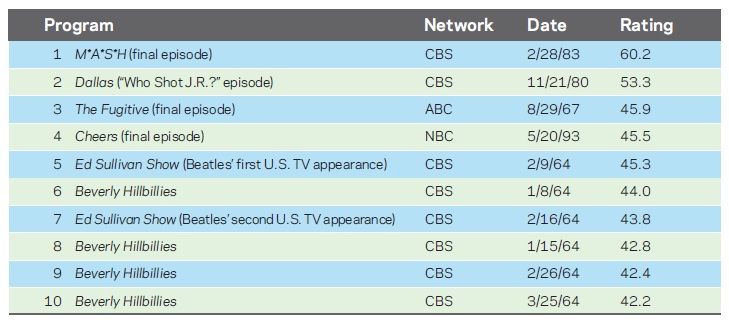Chapter 6 Visual Activities 2
Chapter 6 Visual Activities 2
CHAPTER 6: TELEVISION AND CABLE: THE POWER OF VISUAL CULTURE
Focus Questions
Do the shows on this list have anything in common?
Are there any shows that you expected to be on this list, but aren’t?
The Top 10 Highest-Rated TV Series; Individual Programs (since 1960).

1 of 2
Short-Answer Questions
Question
/sELG2cT+9OM9q3O63QLBYq+YakDTXcOsbkrHMHh7hYsfKn5+HDXyFy/+YmDu6GnkuBnDt5hH7CXu7mqQ7qzUtiE0f56ITehDeUWfihFoK+Ekx9mNjlccspMtHpUHlHYmAe/P8mk7Id9fz3uvQm7HQVQBP7R7TnsGT97gqJsnUM=Seven of the Top 10 shows originally aired between 1964 and 1967, the period leading up to the height of the network era. CBS, NBC, and ABC held a veritable monopoly on TV audiences. Nowadays, with increasing competition from the Internet, cable, and DVRs, it has become almost impossible for a show to draw a 42-plus rating. More people may be watching television than ever before—but with more options, people are tuning into a wider variety of programs.
2 of 2
Question
1QMQsXjTrZKUg8znT7h4bdBRbXm6fCeOZIgmmr+7cxXjQOkrwgFiXcxMKM22jxyxC2iR4idoZO/KDk7vfTOlo2xBU/QGgAriAZcSjAZ5KhTpdk3H+vUuYDEB+i/qU1RtYRggXpG0h9QM16T6Advertisers would also be interested in a show’s share. Unlike ratings, shares don’t take into account the television sets that aren’t being used at the time of the sample. Shares are particularly important during fringe times (like late night or midday), when most television sets may be turned off. Not only do advertisers want to know when people are watching, they also want to know who is watching, hence their interest in specific audience demographics—from race and gender to age, occupation, and educational background. Prime-time advertisers are mainly interested in securing affluent eighteen- to forty-nine-year-old viewers, who account for most consumer spending.